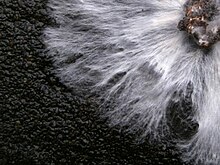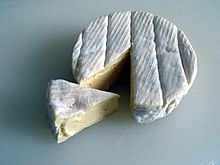Mycelium

The mycelium (final emphasis: neo-Latin mycelium and modern Greek μυκήλιο [ν] from Greek μ griechκης mýkēs 'mushroom' and ήλος hḗlos 'nail') or mycelium , plural mycelia or mycelia , also mycele or mycelium , is the totality of all hyphae , i.e. the thread-like cells of a fungus or bacterium (for example in streptomycetes ).
The individual hyphae are usually not visible to the naked eye, but only microscopically . However, mycelia with dense hyphae can be seen in their entirety with the naked eye, for example mold mycelia in otherwise clear fruit juices, fungal mycelia on the surface of Camembert cheese, “mold” on food.
In common parlance, only the visible fruiting bodies are called mushrooms . In the case of edible mushrooms, however, the actual fungus is predominantly the fine mycelium consisting of hyphae in the soil or - in the case of tree fungi - in the wood, which is usually not perceived because of its occurrence in these opaque substrates. Fungal mycelia can reach a size of over a square kilometer, a huge biological mass and an old age, for example in honey mushrooms .
Dikaryotic mycelium (pair nucleus mycelium) is a mycelium that contains two nuclei with different genomes in each cell , a plus nucleus and a minus nucleus . It is formed by the fusion of two monokaryotic mycelia, a plus mycelium of the plus mating type and a minus mycelium of the minus mating type, which in turn germinate from monokaryotic spores. In the case of mushrooms , the cell division of the dikaryotic cells in the mycelia is often associated with the formation of buckles ("buckle mycelium ").

